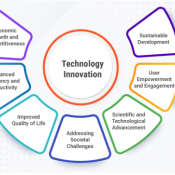

Progressive Technological Advancement Enhancing Solutions Empowering Societies
Technological innovation refers to the process of creating and implementing new or significantly improved technologies, products, services, or processes to bring about a positive change or gain a competitive advantage. It involves the application of scientific and practical knowledge to develop new solutions, improve existing ones, and address various challenges in different fields such as business, healthcare, communication, and manufacturing.
Creation and Development:
New Technologies: Innovations often involve the creation of entirely new technologies. This could be in the form of hardware, software, materials, or methodologies.
Improvement of Existing Technologies: It can also entail significant improvements or advancements in existing technologies, making them more efficient, reliable, or cost-effective.
Problem Solving and Improvement:
Addressing Challenges: Technological innovations aim to address specific problems or challenges faced by individuals, businesses, or society at large. These challenges could be related to efficiency, safety, environmental concerns, or any other aspect where improvement is needed.
Enhancing User Experience: Innovations often focus on enhancing user experience, making products or services more user-friendly, accessible, and enjoyable.
Implementation and Integration:
Commercialization: Innovations are not limited to conceptualization but involve the process of bringing the new technology or product to the market. This includes manufacturing, marketing, and distribution.
Integration into Society: Innovations often lead to societal changes as they become integrated into daily life, affecting how people work, communicate, and interact.
Research and Development:
Investment in Research: Innovation is often preceded by extensive research and development efforts. This involves scientific inquiry, experimentation, and testing to create a solid foundation for the innovation.
Continuous Improvement: Innovators constantly engage in research to refine and improve their creations, ensuring they stay relevant and competitive.
Collaboration and Interdisciplinary Approaches:
Collaboration: Innovation often involves collaboration among experts from various fields. Engineers, scientists, designers, and business professionals may work together to bring a new idea to fruition.
Interdisciplinary Approach: Innovations can emerge at the intersection of multiple disciplines, where ideas and concepts from different fields are combined to create something new and groundbreaking.
Market Impact and Competitive Advantage:
Market Disruption: Innovative technologies can disrupt existing markets, rendering old products or services obsolete and creating new market dynamics.
Competitive Advantage: Companies that innovate gain a competitive advantage by offering unique or superior products or services, allowing them to differentiate themselves from competitors.
Adaptability and Future Outlook:
Adaptability: Innovation is not a one-time event; it requires continuous adaptation and evolution. Technologies need to adapt to changing circumstances and user needs.
Future Outlook: Innovations often have a long-term perspective, aiming to anticipate future challenges and opportunities, and prepare society and businesses for what lies ahead.
Defining Technological Innovation
At its core, technological innovation refers to the process of applying new or improved technologies to create a valuable outcome. It involves the development, implementation, and integration of innovative ideas and technologies to enhance products, services, or processes within a business or entrepreneurial venture.
Importance of Technological Innovation
Technological innovation plays a pivotal role in shaping the future of businesses and entrepreneurship.
Driving Competitive Advantage
In the ever-evolving market, businesses that embrace technological innovation gain a significant edge over their competitors. By adopting cutting-edge technologies, companies can enhance their efficiency, reduce costs, and deliver superior products or services to their customers.
Fostering Growth and Expansion
Innovation opens doors to new opportunities and markets. Businesses that invest in technological advancements often experience rapid growth and expansion. Whether it's entering new markets or diversifying product offerings, innovation acts as a catalyst for business development.
Enhancing Customer Experience
Technological innovations empower businesses to create seamless and personalised experiences for their customers. From user-friendly apps to efficient customer service solutions, innovation enhances customer satisfaction, fostering loyalty and repeat business.
Sustainability and Environmental Impact
In recent years, technological innovation has been instrumental in developing eco-friendly solutions. Businesses are now focusing on sustainable practices, reducing their environmental footprint, and creating products or services that contribute positively to the planet.
Types of Technological Innovation
Technological innovation can be categorised into several types, each with its unique characteristics and applications:
Product Innovation
Product innovation involves the development of new or improved products to meet market demands. This type of innovation focuses on enhancing the features, functionalities, or design of existing products or creating entirely new products.
Process Innovation
Process innovation revolves around improving internal processes and operations within a business. It aims to enhance efficiency, reduce costs, and streamline workflows. Automation, workflow redesign, and the implementation of advanced technologies are common examples of process innovation.
Service Innovation
Service innovation pertains to the development of new or improved services offered by businesses. It focuses on creating innovative service delivery methods, improving customer interactions, and enhancing the overall service experience.
Business Model Innovation
Business model innovation involves redefining the fundamental aspects of how a business operates. It encompasses changes in revenue streams, target markets, partnerships, and value propositions. Businesses embracing this type of innovation often disrupt traditional industries and create new market paradigms.
Real-Life Examples of Technological Innovation
Technological innovation manifests in various forms across different industries. Here are a few notable examples:
Artificial Intelligence and Machine Learning in Healthcare
Healthcare institutions are leveraging AI and machine learning algorithms to diagnose diseases, predict patient outcomes, and optimize treatment plans. These innovations enhance patient care and contribute to medical advancements.
E-commerce Platforms and Mobile Payment Solutions
E-commerce platforms continually innovate to enhance user experience. Features such as personalised recommendations, augmented reality shopping experiences, and seamless mobile payment solutions have revolutionised the way people shop online.
Renewable Energy Technologies
Innovations in solar, wind, and hydroelectric technologies have transformed the energy sector. Renewable energy sources are becoming more efficient, cost-effective, and accessible, reducing reliance on fossil fuels and mitigating climate change.
3D Printing in Manufacturing
3D printing technology has revolutionised the manufacturing industry. It enables rapid prototyping, customisation of products, and efficient production processes. Manufacturers can create intricate designs and prototypes with precision, leading to advancements in various sectors.
Conclusion
In conclusion, technological innovation serves as the driving force behind business evolution and progress. By understanding its definition, types, and real-life examples, businesses and entrepreneurs can harness the power of innovation to navigate the challenges of the modern world successfully. Embracing technological advancements not only ensures survival in a competitive landscape but also paves the way for sustainable growth, enhanced customer experiences, and positive contributions to society and the environment. Stay innovative, stay ahead.
FAQs
What is technological innovation and its importance?
Technological innovation involves applying new or improved technologies to create valuable outcomes. Its importance lies in driving competitive advantage, fostering growth, enhancing customer experience, and promoting sustainability.
What is technological innovation and its types?
Technological innovation includes product innovation, process innovation, service innovation, and business model innovation. Each type focuses on different aspects of a business, from improving products and services to redefining operational strategies.
What is an example of a technological innovation?
A prime example of technological innovation is the integration of artificial intelligence and machine learning in healthcare. These technologies enable predictive analytics, personalised treatments, and efficient healthcare delivery, improving patient outcomes.
What is the best definition of innovation?
Innovation refers to the process of introducing new ideas, methods, or products to create value or solve problems. It encompasses creativity, research, development, and implementation of novel solutions to address evolving needs and challenges.















